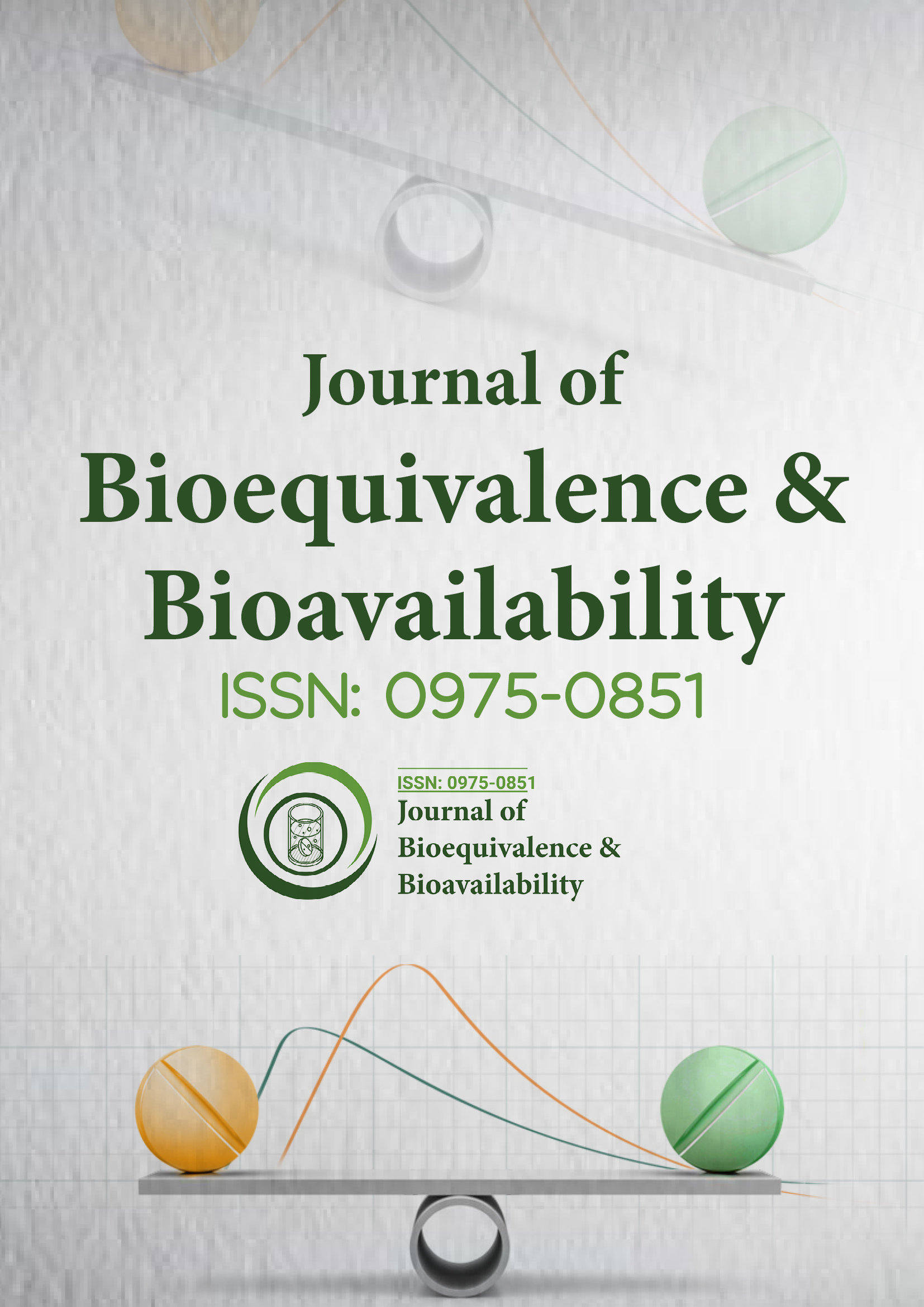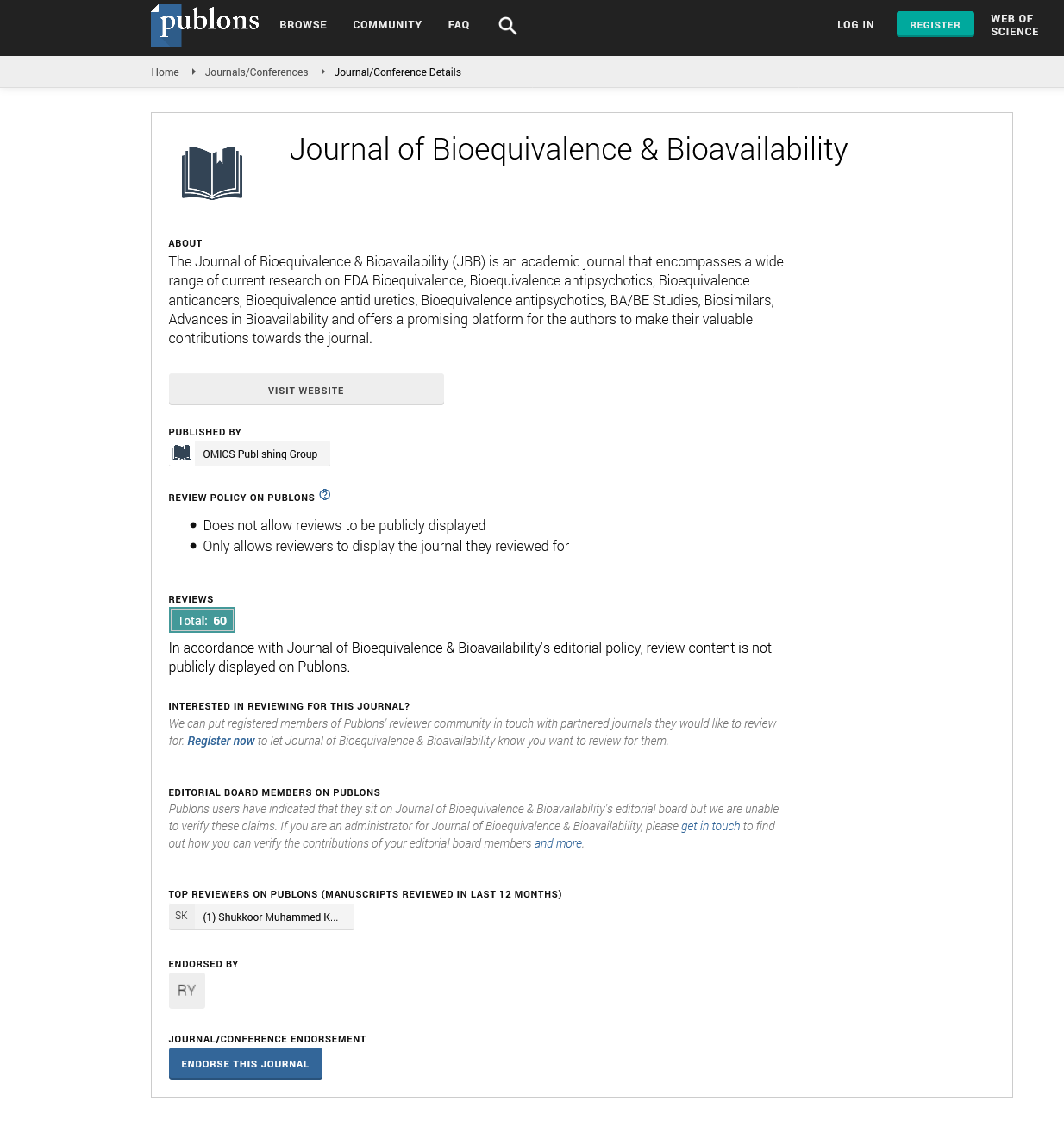Indexed In
- Academic Journals Database
- Open J Gate
- Genamics JournalSeek
- Academic Keys
- JournalTOCs
- China National Knowledge Infrastructure (CNKI)
- CiteFactor
- Scimago
- Ulrich's Periodicals Directory
- Electronic Journals Library
- RefSeek
- Hamdard University
- EBSCO A-Z
- OCLC- WorldCat
- SWB online catalog
- Virtual Library of Biology (vifabio)
- Publons
- MIAR
- University Grants Commission
- Geneva Foundation for Medical Education and Research
- Euro Pub
- Google Scholar
Useful Links
Share This Page
Journal Flyer

Open Access Journals
- Agri and Aquaculture
- Biochemistry
- Bioinformatics & Systems Biology
- Business & Management
- Chemistry
- Clinical Sciences
- Engineering
- Food & Nutrition
- General Science
- Genetics & Molecular Biology
- Immunology & Microbiology
- Medical Sciences
- Neuroscience & Psychology
- Nursing & Health Care
- Pharmaceutical Sciences
Opinion - (2025) Volume 17, Issue 2
Bioequivalence Challenges in Narrow Therapeutic Index Cardiovascular Medications
Emily Nadine*Received: 30-Apr-2025, Manuscript No. JBB-24-28986; Editor assigned: 07-Apr-2025, Pre QC No. JBB-24-28986 (PQ); Reviewed: 21-Apr-2025, QC No. JBB-24-28986; Revised: 28-Apr-2025, Manuscript No. JBB-24-28986 (R); Published: 05-May-2025, DOI: 10.35248/0975-0851.25.17.633
Description
Bioequivalence has emerged as a cornerstone in the development and regulatory approval of generic drugs, ensuring therapeutic equivalence with innovator products. Nowhere is this principle more crucial than in the field of cardiovascular medicine, where drug therapy forms the backbone of managing life-threatening conditions such as hypertension, heart failure, arrhythmias, and ischemic heart diseases. With the growing burden of cardiovascular diseases globally and the economic imperatives to reduce healthcare costs, the push for bioequivalent cardiovascular generics has gained considerable momentum. However, the application of bioequivalence standards to cardiovascular drugs raises unique challenges and demands a balanced, evidence-based approach.
Cardiovascular drugs span a diverse array of pharmacological classes beta-blockers, calcium channel blockers, angiotensin-converting enzyme inhibitors, statins, antiplatelet agents, and anticoagulants each with distinct pharmacodynamic profiles and therapeutic indices. For drugs with a wide therapeutic index, such as statins, minor variations in plasma concentration are less likely to translate into clinical risk. However, for Narrow Therapeutic Index (NTI) drugs like digoxin or antiarrhythmics such as amiodarone, small deviations in bioavailability can result in subtherapeutic effects or toxicity. This raises a critical concern over the adequacy of current bioequivalence thresholds in capturing the nuances of NTI cardiovascular agents.
The nocebo effect — a phenomenon where negative expectations toward a generic product trigger adverse outcomes — is especially pronounced in cardiovascular medicine. Patients accustomed to a specific brand may experience anxiety, reduced adherence, or report side effects when switched to a different-appearing generic, despite its pharmacological equivalence. This psychosomatic response has tangible implications for therapeutic continuity and underscores the importance of physician-patient communication and education when implementing generic substitution policies.
Moreover, cardiovascular outcomes often depend on long-term drug exposure, requiring consistency in drug plasma levels over extended periods. Bioequivalence studies, typically conducted over a short duration in healthy volunteers under fasting conditions, may not adequately capture the real-world dynamics of chronic cardiovascular therapy. Critics contend that reliance on single-dose, fasted-state studies may not reflect drug performance in the fed state or in patients with cardiovascular comorbidities who exhibit altered gastrointestinal physiology and drug absorption patterns.
There is also a broader socio-economic dimension to the debate on bioequivalence in cardiovascular products. The widespread availability of generics has undoubtedly enhanced drug accessibility, particularly in low and middle-income countries where out-of-pocket healthcare expenditure is significant. Generic cardiovascular drugs have helped reduce mortality and morbidity by enabling continuous, affordable treatment. Nonetheless, disparities in manufacturing quality, regulatory oversight, and post-marketing surveillance across different regions continue to raise questions about the interchangeability of generics sourced from various manufacturers.
International harmonization efforts such as the WHO Prequalification Programme and ICH guidelines have attempted to standardize quality benchmarks for generic cardiovascular products. Yet, enforcement remains uneven, and lapses in quality can have dire consequences. Reports of batch variability, bioequivalence failures, or therapeutic inequivalence continue to emerge, particularly in unregulated markets. These incidents erode public trust in generics and necessitate robust pharmacovigilance systems to detect and address safety concerns.
The pharmaceutical industry must also recognize the evolving landscape of bioequivalence assessment, where traditional pharmacokinetic endpoints may be supplemented with pharmacodynamic markers, modeling and simulation techniques, or Real-World Evidence (RWE). For cardiovascular drugs, especially antithrombotics or antiarrhythmics, integrating surrogate biomarkers such as platelet aggregation levels or electrocardiographic endpoints could provide a more clinically relevant measure of equivalence. Additionally, the adoption of Model-Integrated Evidence (MIE) approaches could help predict therapeutic equivalence across diverse populations, dosing conditions, and formulations.
While the scientific discourse around bioequivalence is heavily focused on technical rigor, the ethical implications deserve equal attention. Clinicians have a moral obligation to ensure that patients receive medications that are not only cost-effective but also therapeutically reliable. Informed consent, transparency about potential risks and benefits of switching to generics, and the availability of pharmacovigilance data should be integral to any bioequivalence-driven substitution policy.
Citation: Nadine E (2025). Bioequivalence Challenges in Narrow Therapeutic Index Cardiovascular Medications. J Bioequiv Availab. 17:633.
Copyright: © 2025 Nadine E. This is an open-access article distributed under the terms of the Creative Commons Attribution License, which permits unrestricted use, distribution, and reproduction in any medium, provided the original author and source are credited.

